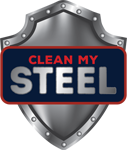How to Prevent Rust and Corrosion on Stainless Steel Surfaces
Posted by Eric Goldman on
Stainless steel is known for its durability and resistance to corrosion, making it an ideal material for a wide range of applications, from kitchen appliances to industrial equipment. However, even stainless steel can rust and corrode over time if it's not properly cared for. In this blog post, we'll discuss how to prevent rust and corrosion on stainless steel surfaces.
-
Clean Regularly: Regular cleaning is the most important step in preventing rust and corrosion on stainless steel surfaces. Dirt, grime, and other contaminants can weaken the protective layer of the stainless steel, allowing rust to form. To clean stainless steel surfaces, use a mild soap and warm water, and rinse thoroughly. Avoid using harsh abrasives or steel wool, as these can scratch the surface and create areas where rust can form.
-
Dry Thoroughly: After cleaning, it's important to dry stainless steel surfaces thoroughly to prevent water spots and rust. Use a soft, clean cloth to wipe down the surface, and make sure to remove any standing water from corners and crevices. For best results, use a microfiber cloth, which is gentle and won't scratch the surface.
-
Apply a Protective Coating: There are a variety of protective coatings available that can help prevent rust and corrosion on stainless steel surfaces. These coatings create a barrier between the metal and the environment, helping to keep moisture and other contaminants at bay. Some coatings are designed specifically for outdoor use, while others are intended for use in more controlled environments. Be sure to choose a coating that's appropriate for your specific application.
-
Avoid Exposure to Chlorides: Chlorides are one of the biggest culprits when it comes to causing rust and corrosion on stainless steel. Chlorides are commonly found in salt water, bleach, and some cleaning products. Avoid exposing stainless steel surfaces to these substances whenever possible, and if exposure does occur, rinse the surface thoroughly with fresh water.
-
Inspect Regularly: Even with proper care, stainless steel surfaces can still develop rust and corrosion over time. To prevent this from happening, it's important to inspect your stainless steel surfaces regularly for signs of damage. Look for areas where the protective layer has been compromised, such as scratches or dents, and address these issues as soon as possible.
In conclusion, preventing rust and corrosion on stainless steel surfaces requires regular cleaning, proper drying, the use of protective coatings, avoidance of chlorides, and regular inspection. By following these simple steps, you can help ensure that your stainless steel surfaces remain in top condition for years to come.
Share this post
- 0 comment
- Tags: clean my stainless steel, clean stainless steel, Innocare, Stainless Steel Protection, Stainless Steel Rust Protection
